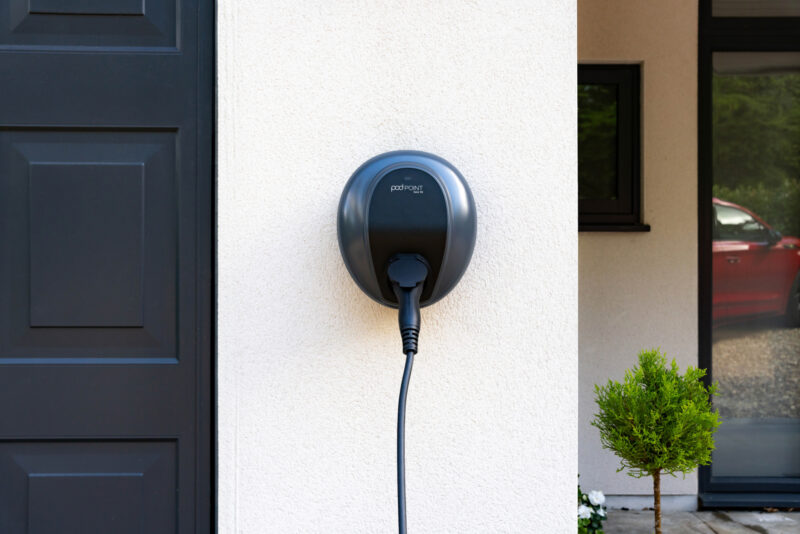Domestic vs Commercial Charger Installation
An overview comparing how EV chargepoint installations for homes and businesses differ, and why they have different processes.
Last updated: Jul 26, 2024 • 8 min read

Pod Point offers electric vehicle (EV) charging for both homes and businesses. There are a number of differences between domestic and commercial chargepoint installations:
Home chargepoint installations tend to follow a similar installation procedure.
Commercial projects vary depending on a number of factors including scale, site layout, and who the charging is for.
There are separate regulations for domestic and commercial installations set by the Office for Zero Emissions Vehicles (OZEV).
Some grants can only be claimed by businesses, whilst others are exclusively for homes.
Domestic and commercial installations compared
Domestic installations cover the fitting of chargepoints for use at homes. They are used exclusively by homeowners and their visitors. Installations are carried out by Pod Point Experts who are highly trained and experienced electricians. Most homechargers are installed on the exterior of the property, or inside the garage.
By comparison, commercial and workplace charging installations will either be used by:
The company’s employees
Fleet vehicles
Customers
As such, they tend to be more complex than home installations as commercial chargers are required to have additional technologies to install and operate.
To overcome this added complexity, commercial installations are overseen by a Pod Point Project Manager who liaises with all the stakeholders/parties involved to ensure the installation is completed correctly.
Why do they have different installation processes?
Externally, there is very little difference between a domestic and a commercial Solo charger. But internally, commercial chargepoints are made up slightly differently to satisfy regulatory requirements, which is why a business can’t simply get a domestic charger installed, or vice versa.
On the other hand, Twin Chargers can only be used for commercial installations. Homes wanting more than one chargepoint will need to purchase multiple Solo chargers.
But there are other factors involved that require domestic and commercial installations to have different processes.
Home installations are less complex
A normal home installation typically takes around 2 hours to complete. This is because domestic installations tend to follow a similar procedure. This is why Pod Point is able to offer a single standard installation package for homes, and why home installs are cheaper than commercial installs.
For starters, most properties in the UK with off-street parking only have a single space, which is why the majority of domestic installations are for a standard single-socket charger. The chargepoint is usually installed to the exterior of the property.
Tip: A freestanding mount can be used to hold up to two Solo chargers if there is no suitable wall mounting space available.

Whether using a mount or fixing to a wall, the chargepoint is connected directly to the property’s power supply. In most homes, this is within 15m of the chargepoint’s location, which negates the need for any groundworks. This means home installations only require a single engineer to complete the work.
Also, domestic installations can come straight off the home’s electric meter, which is often easy to route from. By comparison, commercial installations need to come from the fuse board, which is typically located in the middle of the property.
Additionally, most standard home consumer units run on single-phase power, whereas commercial distribution boards typically have three-phase power. As a result, home power supplies are typically smaller and easier to work with.
Commercial installations are more varied
Whilst most home installations are fairly identical, business installations can vary significantly, especially in terms of scale.
Business premises usually have multiple bays, sometimes spread out across different storeys of a car park. This in turn means they need to provide charging for many users at the same time.
Tip: Pod Point’s dual socket Twin Charger can charge two electric vehicles at once, and is available in 7kW, or 22kW power ratings.

As a result, business installations will rarely involve just one or two chargepoints. Naturally, a higher number of chargepoints being installed makes for a more complicated and expensive installation process.
Also, unlike home installations, the parking bays are rarely located close to the premises’s power supply or a permanent wall. To overcome this, groundworks are often needed to trench the cables underground so they don’t get damaged by the elements or vehicles.
This adds an extra layer of complexity, but also time, with groundworks typically spanning multiple days depending on the size of the car park.
Tip: Pod Point’s Commercial Charging solution utilises passive wiring to help businesses prepare for future expansion and easily add new chargepoints as EV adoption increases.
To ensure the process goes smoothly, every commercial installation is assigned a Pod Point Project Manager. Their role is to oversee the whole project from end-to-end, starting with the initial quote through to completion and after sales support
This gives the business and everyone involved a central point of contact with sufficient knowledge of the installation to offer guidance and support when needed.
Businesses have different power rating requirements
EV drivers typically plug their vehicles in to charge overnight so they have a full battery at the start of the day. Because of this, a 7kw charger is usually more than sufficient to cover any charging taking place at home.
But businesses have different requirements depending on who the chargepoints are being used by. This in turn impacts what power rating(s) they choose to install. In some instances, sites may find a mixture of power ratings more appropriate, which results in a more complex installation process:
Workplace charging
Workplaces may also need a variety of power ratings depending on business hours and shift patterns.
For businesses where employees are at work for a full 8 hour day - whether during the day or overnight - a 7kW power rating is more than sufficient as their EVs will be plugged in for extended periods of time.
However, not all employees will be parked for the entire time, which is where a mixture of 7kW and 22kW (or even higher) power ratings would be beneficial. This way, employees who frequently need to drive to and from the office can get a quick top-up charge.
Fleet charging
Businesses with a fleet of vehicles may find a mixture of power ratings more appropriate. 7kW chargers will still be useful to allow for overnight charging, but faster chargers with power ratings of 22kW+ may also be desired to give a faster top-up charge in between deliveries.
Unlike homes, most businesses run on three-phase power, which can handle the higher load demands from faster chargepoints. However, the power supply may need to be upgraded to accommodate multiple chargers, depending on the size of the business and its on-site power availability.
Tip: Pod Point’s Array Charging system makes efficient use of the site’s available supply to maximise the number of chargepoints that can be installed. Array Charging load balances the chargepoints and lets businesses fit up to 27 sockets on a single 100A three-phase supply.
Commercial (customer) charging
A business providing charging for its customers will choose its power rating based on average dwell times. For example, 7kW chargers would be suitable for premises where customers are expected to be for long periods of time such as airports, hotels, or venues like football stadiums or zoos.
But some public destinations like supermarkets and shopping centres have a broader range of dwell times. In these instances, a mixture of fast and rapid chargepoints would be more beneficial to cater to both long-stay customers - where 7kW may be sufficient - and those visiting for a short period who may need a faster charge.

Regulatory differences
Domestic and commercial chargepoints have to satisfy different regulations set by OZEV. Commercial chargers in particular have a broader range of regulations they need to adhere to.
Tip: OZEV has a list of approved models that can be installed in commercial settings to help businesses choose their chargepoints.lig
Businesses must be able to restrict usage to different usage groups, e.g employees, customers etc. Domestic chargepoints don’t need this, as they’re only used by one user.
Commercial chargepoints must have the ability to charge the end user a fee for usage to cover business electricity costs. Some public chargepoints are free to use, but they must have the functionality to set a custom tariff if desired. This is done through Pod Point’s back-end Site Management Service .
Home chargepoints need to have smart functions, but these can all be accessed by the user with the Pod Point App. This gives full visibility on their energy usage, as well as the ability to set repeating schedules with Charge Scheduling.
If a business installs a domestic chargepoint, the warranty will be invalid.
Contractors need to sit additional qualifications to work on business premises, which is monitored by OZEV through their WCS-approved installer scheme.
There are different grants for commercial and domestic chargepoints
OZEV offers different grants for home and business chargers. The main grants available are:
The Workplace Charging Scheme (WCS), which is also available for any business, charity, or public authority.
The EV chargepoint grant for residential and commercial landlords, social housing providers, and property factors.
The EV chargepoint grant for flat owner-occupiers and people living in rented properties.
As a result, businesses wanting to install chargepoints will have to opt for chargers on OZEV’s commercial-approved list in order to claim the relevant grant.

